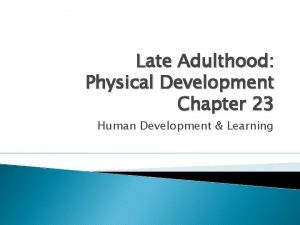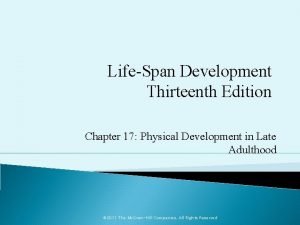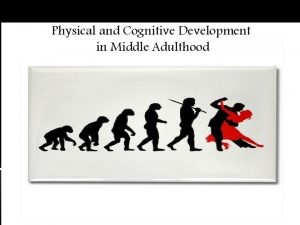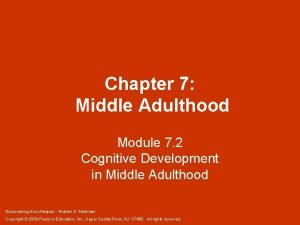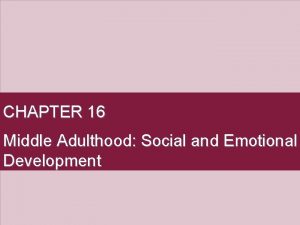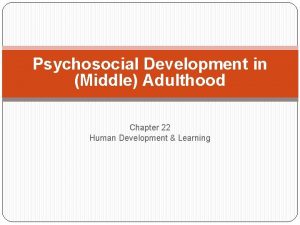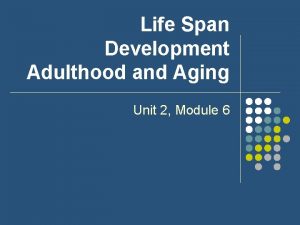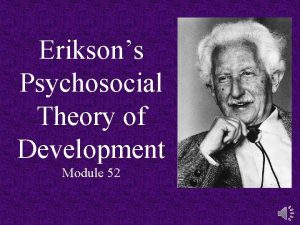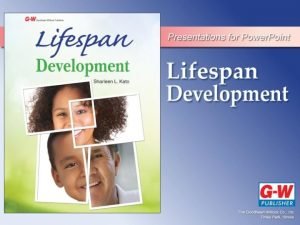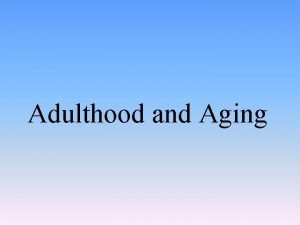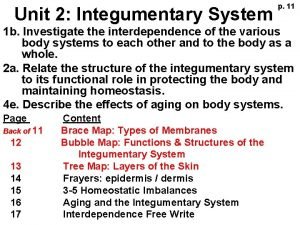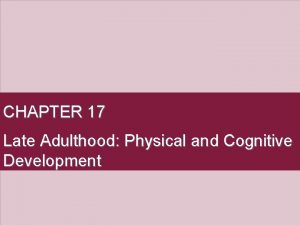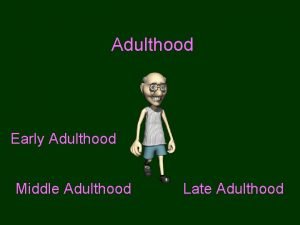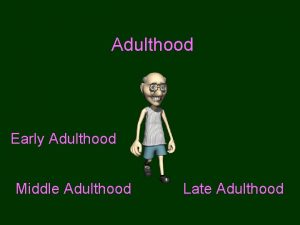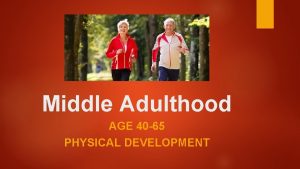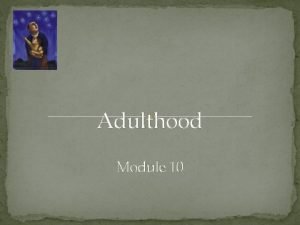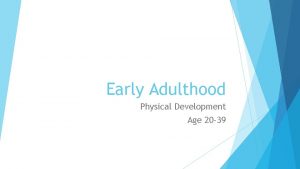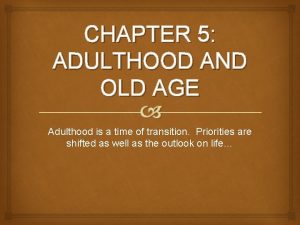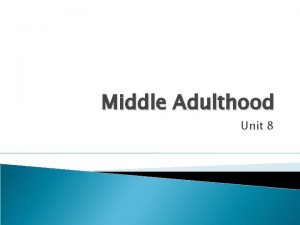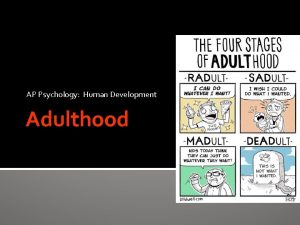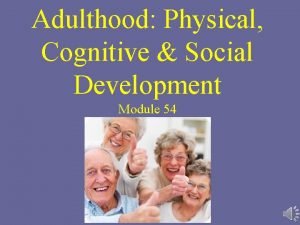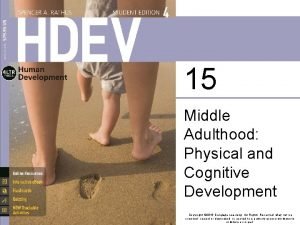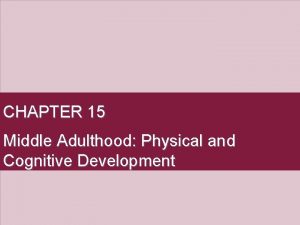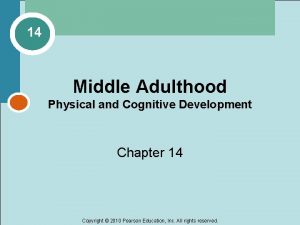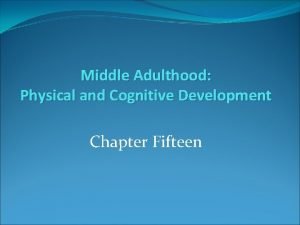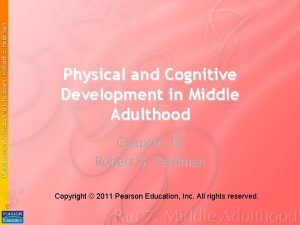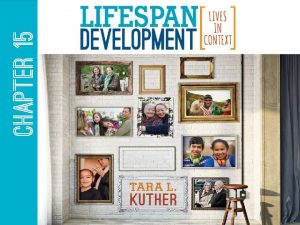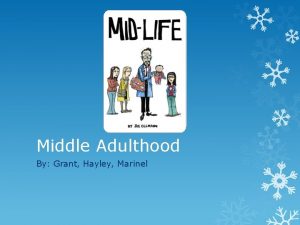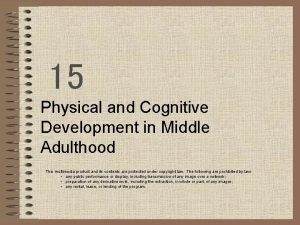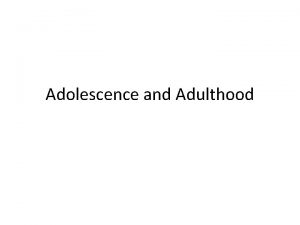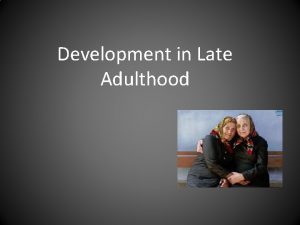Middle Adulthood Physical Development Highlights I Middle Age



























- Slides: 27

Middle Adulthood

Physical Development: Highlights I. Middle Age: A Cultural Construct A. When Is Middle Age? No consensus on when it begins and ends. Often defined as 40 -65 years of age. No specific biological or social events that mark its boundaries. In the US, middle-age is increasingly a state of mind. Many people in their sixties and seventies consider themselves middle-aged.

II. Sex and Health A. Menopause: the cessation of menstruation and of the ability to bear children, typically around age 50. Symptoms: Most common (among 50% of women)…hot flashes. Other symptoms include…Vaginal dryness, burning, itching. Sexual appetite remains. B. Erectile Dysfunction: the inability of a man to achieve or maintain an erect penis sufficient for satisfactory sexual performance. Biological Causes: Diabetes High Blood Pressure or Cholesterol Neurological Disorders Kidney Failure Other Causes: Drugs/Alcohol Unsatisfying Relationship Psychological Factors Stress

III. Stress and Health It’s not what happens, it’s how you take it. A. Allostasis: the ability to adapt to stress. B. Allostatic Load: damage that occurs when coping abilities are inadequate. Contributing Factors… Positive or negative change Illness Death of spouse or divorce Marriage Unemployment Occupational stress and ‘burnout’ 1) Burnout: emotional exhaustion and a sense that one can no longer accomplish anything on the job.

Cognitive Development I. Schaie: A Seven Stage Life-Span Model of Cognitive Development A. Responsible Stage: the third of Schaie’s seven cognitive stages, in which middle-aged people are concerned with longrange goals and practical problems related to their responsibility for others, such as family members or employees. B. Executive Stage: the fourth of Schaie’s seven cognitive stages, in which middle-aged people responsible for societal systems deal with complex relationships on several levels. C. Reorganizational Stage: the fifth of Schaie’s seven cognitive stages, in which adults entering retirement reorganize their lives around nonwork-related activities.

II. Schaie: The Seattle Longitudinal Study

A. The Flynn Effect: every decade, raw scores in IQ tests have risen and test makers have had to make the tests harder to keep the mean score at 100. Likely due to… (1) Improved health and nutrition, (2) Better education, (3) Increased opportunity for visual-spatial stimulation (TV/Video games), (4) Improved test-taking skills III. Horn and Cattell: Fluid and Crystallized Intelligence A. Fluid intelligence: the type of intelligence which is applied to novel problems and is relatively independent of educational and cultural influences. B. Crystallized intelligence: the type of intelligence involving the ability to remember and use learned information; it is largely dependent on education and cultural background.

IV. Expertise Mature adults show increasing competence solving problems in their field. A. Encapsulation. . . Information processing becomes dedicated to specific knowledge. Captures fluid ability for expert problem solving. Can help buffer age-related declines in cognitive ability. B. Expert Pattern Recognition V. Integrative Thought Mature adults are better at integrating. . . Logic with intuition and emotion. Conflicting facts and ideas. New and old information.

VI. Creativity A. Creative Potential: the talent for creativity that is present in a person, such as a child, but not yet realized in fact. B. Creative Performance: what, and how much, a creative mind produces. Combination of forces. . . Biological Personal Social and cultural Specific contributions to creativity. . . Highly organized knowledge of the subject. Intrinsic motivation to work. Strong emotional attachment to work. Willingness to take risks and tolerate rejection.

Psychosocial Development I. Change At Midlife: Classic Theoretical Approaches A. Proponents of Stability. . . Psychoanalytic theory (Freud) Trait models of personality B. Proponents of Change. . . Humanistic theorists (Rogers & Maslow) 1) Self-Actualization: to strive for and to achieve one’s fullest potential.

2) Unconditional Positive Regard: the acceptance of the person as he or she is. 3) Conditional Positive Regard: the person is only held in esteem when they fulfill certain requirements set for them by another person or society. C. Normative-Stage Models 1) Generativity versus Stagnation: Erikson’s seventh stage of psychosocial development, in which middle-aged adults develop a concern with establishing, guiding, and influencing the next generation or else experience stagnation (a sense of inactivity or lifelessness). Virtue attained… a) Care: a widening commitment to take care of the persons, the products, and the ideas one has learned to care for.

D. Kotre’s Four Forms of Generativity 1) Biological: conceiving and bearing children. 2) Parental: nurturing and raising children. 3) Technical: teaching skills to apprentices. 4) Cultural: transmitting cultural values and institutions. E. Kotre’s Two Methods for Expressing Generativity 1) Communal: the expression of generativity involving care and nurturance of others. 2) Agentic: the expression of generativity involving personal contributions to society. F. Vaillant, Levinson, & Neugarten 1) Interiority: an introspective tendency at midlife.

II. The Self at Midlife: Issues and Themes A. Midlife Crisis: a stressful life period precipitated by the review and reevaluation of one’s past, typically occurring in the early to middle forties. B. Midlife Review: an introspective examination that often occurs in middle age, leading to reappraisal and revision of values and priorities. C. Developmental Deadlines: time constraints on one’s ability to accomplish certain things, like having a baby. D. Ego-resiliency: the ability to adapt flexibly and resourcefully to potential sources of stress.

1) Occurrence is rare Some experience turmoil. Others feel they are at their peak. Least likely among those with ego-resiliency. . . Able to adapt to stress. Have a sense of mastery and control. 2) Midlife is just one of many transitions. Middle age may be stressful. But no more than other stages of life. E. Turning Points: psychological transitions that involve significant change in the person’s life… these happen throughout the lifespan.

F. Identity Process Model: Whitbourne’s model of identity development based on the processes of assimilation and accommodation. 1) Identity: a schema that individuals use to interpret their experiences. 2) Identity Assimilation: effort to fit new experiences into an existing self-concept. 3) Identity Accommodation: adjusting the self-concept to fit new experiences.

G. Identity Style: the characteristic ways of confronting, interpreting, and responding to experience. 1) Assimilative Identity Style: referring to a person who uses assimilation more than accommodation in adapting a self-concept. 2) Accommodative Identity Style: referring to a person who uses accommodation more than assimilation in adapting a self-concept. 3) Balanced Identity Style: the healthiest style, in which identity is flexible enough to change when warranted but not unstructured to the point that every new experience causes the person to question fundamental assumptions about the self.

H. Narrative Psychology: the field that views the development of the self as a continuous process of constructing one’s own life story. 1) Exploratory Goals: the goals aimed at a mature understanding of self. 2) Intrinsic Goals: the goals aimed at well-being and/or happiness. 3) Generativity Script: the life story in which generativity plays a key role, and which gives the life story a happy ending.

I. Gender Identity 1) Men’s Gender Identity In middle age many men become more interested in. . . Expression of feelings Intimate relationships Nurturing (Traits traditionally labeled as feminine) 2) Women’s Gender Identity In middle age many women become more. . . Assertive Self-confident Achievement-oriented (Characteristics traditionally labeled as masculine) 3) Gender Crossover Once active parenting is over, there is a reversal of roles. . . Men explore their ‘feminine’ side Women become more dominant and independent

J. Psychological Well-Being and Positive Mental Health 1) Emotionality Decline of negative emotions, such as anger and fear. In middle to late adulthood, both men and women see a surge in positive emotions. Although women are slightly more negative at all ages. 2) Life Satisfaction: Coping and Adapting Most people report being satisfied with life, regardless of age. Positive emotions from pleasant memories tend to persist. Negative emotions from unpleasant memories tend to fade. 3) Ethnic Conservatism: the tendency to resist accommodation and cling to familiar values and practices that give meaning to life. 4) Other Factors…

III. Relationships at Midlife A. Theories of Social Contact 1) Social Convoy Theory: theory of aging which holds that people move through life surrounded by concentric circles of intimate relationships or varying degrees of closeness, such as close friends and family members, on which people rely for assistance, well-being, and social support. 2) Socioemotional Selectivity Theory: theory that people select social contacts throughout life on the basis of the changing relative importance of social interaction as a source of information, as an aid in developing and maintaining a self-concept, and as a source of emotional well-being.


B. Cohabitation and Mental Health Men: More depressed than married counterparts. Women: No differences in mental health from married counterparts. Why the gender difference? Women may want intimacy without obligation of caring for a husband. Men may benefit from the kind of care wives traditionally provide. C. Midlife Divorce 1) Marital Capital: Financial and emotional benefits built up during a long-standing marriage, which tend to hold a couple together.

Reasons for Divorce in Middle Adulthood

IV. Relationships With Maturing Children A. When Children Leave: The Empty Nest 1) Empty Nest: the transitional phase of parenting following the last child’s leaving the parents’ home. Women heavily invested in mothering find this transition difficult. Most women find the transition liberating… A relief from the “chronic emergencies” of parenthood. B. Parenting Grown Children 1) Tight-knit: intergenerational families in which the members live physically close and are emotionally close. 2) Sociable: intergenerational families in which there is less emotional affinity or commitment, although the members live physically close to one another and will occasionally engage in social activities together.

3) Obligatory: intergenerational families in which there is a lot of interaction but little emotional attachment. 4) Estranged: intergenerational families in which there is little to no interaction despite living physically close. 5) Detached: intergenerational families in which members are geographically and emotionally far away from each other. 6) Intimate But Distant: intergenerational families in which members live far away from each other or spend little time with each other, but retain warm feelings. C. Prolonged Parenting: The Cluttered Nest 1) Revolving Door Syndrome: the tendency for young adults to return to their parent’s home (sometimes more than once) while getting on their feet or in times of financial, marital, or other trouble.

V. Other Kinship Ties A. Relationships with Aging Parents 1) Filial Maturity: when middle-aged children, as the outcome of a filial crisis, learn to accept and meet their parents’ need to depend on them. 2) Sandwich Generation: middle-aged adults squeezed by competing needs to raise or launch children and to care for elderly parents. 3) Caregiver Burnout: a condition of physical, mental, and emotional exhaustion affecting adults who care for aged persons.

B. Grandparenthood Grandparenting often begins before the end of active parenting. The average grandparent starts at age 48, has 6 grandchildren, and still has living parents. 68% see at least 1 grandchild every 2 weeks. Grandmothers tend to be ‘kinkeepers’. . . Keep in touch with the grandchildren. Have warmer relationships than grandfathers. Grandparents are the nation’s primary childcare providers. Many spend money on educational needs of children. C. Grandparenting after Divorce and Remarriage After grandchildren’s parents divorce. . . Maternal grandparents. . . tend to have more contact with grandchildren than paternal grandparents. Paternal grandparents. . . the remarriage of the mother further decreases chances for contact.
 Filial maturity
Filial maturity Early adulthood developmental stage
Early adulthood developmental stage Reflective and relativistic thinking
Reflective and relativistic thinking Late adulthood physical development
Late adulthood physical development Physical changes in late adulthood
Physical changes in late adulthood Fraction definition
Fraction definition Physical changes during early adulthood
Physical changes during early adulthood Intellectual development in middle adulthood
Intellectual development in middle adulthood Social development in middle adulthood
Social development in middle adulthood Cognitive development in middle adulthood
Cognitive development in middle adulthood Middle adulthood social changes
Middle adulthood social changes Middle adulthood psychosocial development
Middle adulthood psychosocial development Social development in adulthood
Social development in adulthood Stone age chronology
Stone age chronology Iron age bronze age stone age timeline
Iron age bronze age stone age timeline Early adulthood age erikson
Early adulthood age erikson Mistrust vs trust
Mistrust vs trust Early adulthood age
Early adulthood age Early adulthood age
Early adulthood age Infancy childhood adolescence adulthood old age
Infancy childhood adolescence adulthood old age Physical changes in late adulthood
Physical changes in late adulthood Key highlights icon
Key highlights icon Proposal highlights
Proposal highlights Highlights memorandum
Highlights memorandum Investment highlights
Investment highlights Highlights from the book of isaiah
Highlights from the book of isaiah Highlights from the book of isaiah
Highlights from the book of isaiah Objective for work immersion
Objective for work immersion



